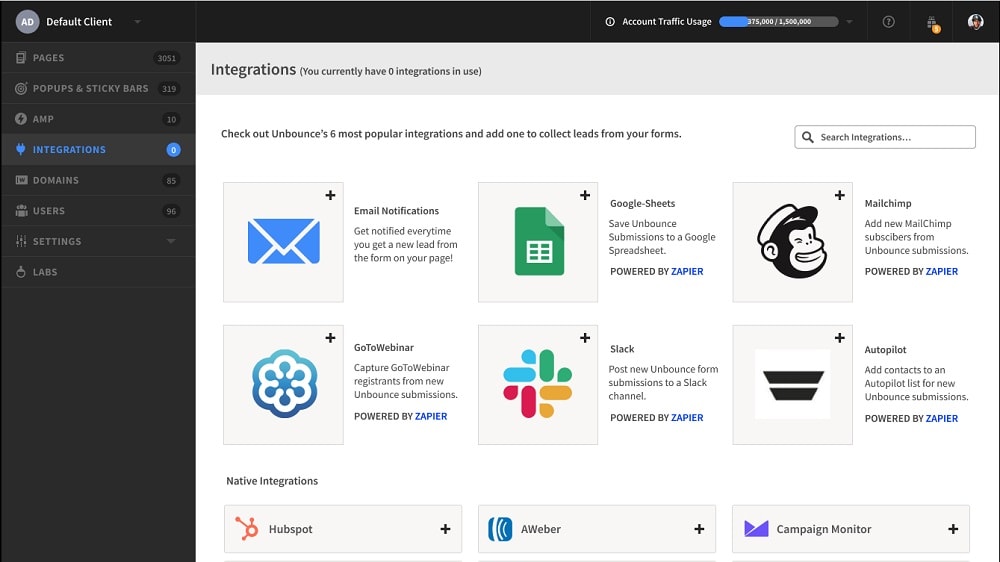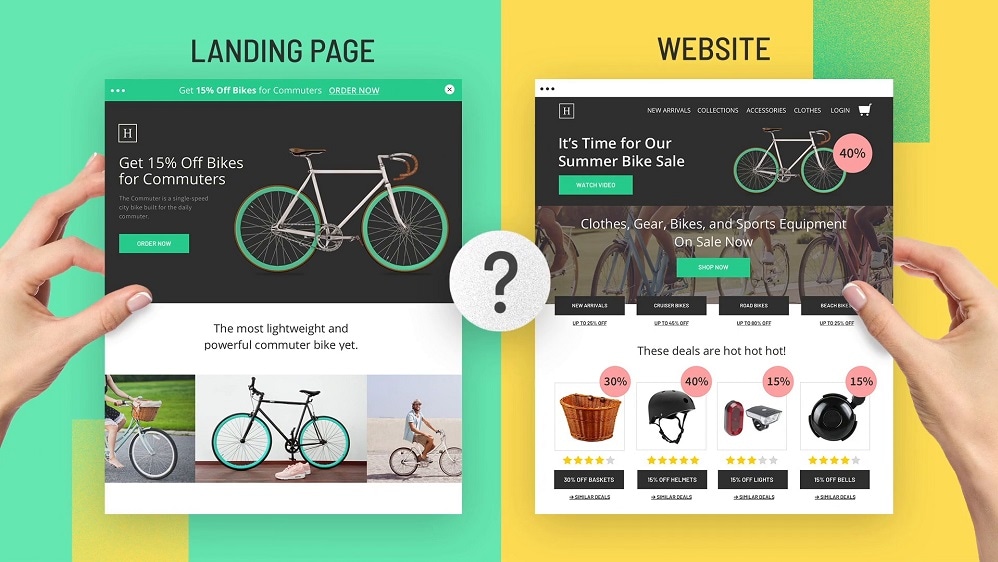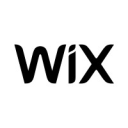Instapage vs Unbounce compared: Which landing page platform should I choose?
- 01Instapage vs Unbounce: overview
- 02What's the difference between Instapage and Unbounce?
- 03Instapage pros and cons
- 04Unbounce pros and cons
- 05Instapage compared to Unbounce
- 06Unbounce compared to Instapage
- 07Features comparison
- 08Instapage vs Unbounce: Which is the best for your business?
- 09Promotions on Marketing Automation software
- 10Alternatives to Instapage & Unbounce
Save up to $2,725 on Unbounce
Save up to $2,725 on Unbounce
In the ideal scenario for digital marketing, your landing page creation and optimization tools would flawlessly drive conversions and enhance your online campaigns. However, when it comes to selecting the best platform for crafting and optimizing landing pages, marketers find themselves navigating through a sea of options.
In this article, we will delve into a detailed comparison between Instapage and Unbounce, examining their core functionalities, differences, and pricing models. By the end of this article, you will have a comprehensive understanding of which platform aligns best with your marketing goals, empowering you to boost your conversion rates and streamline your online advertising efforts effectively.
Instapage vs Unbounce: overview
Instapage and Unbounce stand as formidable contenders in the realm of landing page builders, each tailored to meet the diverse demands of marketers and businesses.
Instapage is celebrated for its intuitive drag-and-drop interface and robust design capabilities, empowering users to create visually stunning and high-converting landing pages with ease. Boasting a wide range of customizable templates and advanced analytics features, Instapage offers a comprehensive solution for optimizing landing page performance and maximizing conversion rates. In contrast, Unbounce prides itself on its user-friendly interface and extensive array of conversion-focused tools. With features like A/B testing, dynamic text replacement, and pop-up overlays, Unbounce empowers marketers to fine-tune their landing pages for maximum impact and ROI.
As we delve deeper into the Instapage vs. Unbounce comparison, we'll explore their key features, pricing structures, and performance metrics to assist you in selecting the ideal platform to elevate your marketing efforts.
What's the difference between Instapage and Unbounce?


When comparing Instapage and Unbounce, there are several key differences that can significantly impact your choice of landing page builder for your marketing campaigns. One of the primary distinctions lies in their approach to landing page creation and optimization.
Instapage is renowned for its emphasis on intuitive design and user experience, offering a wide range of customizable templates and drag-and-drop functionality. With Instapage, users can quickly create visually appealing landing pages without the need for extensive coding knowledge. Moreover, Instapage excels in providing advanced analytics and A/B testing capabilities, allowing marketers to optimize their landing pages for maximum conversion rates effectively.
On the other hand, Unbounce distinguishes itself with its focus on conversion optimization and lead generation. While also offering a user-friendly interface and drag-and-drop editor, Unbounce places a stronger emphasis on features like dynamic text replacement, pop-up overlays, and sticky bars to engage visitors and drive conversions. Additionally, Unbounce provides comprehensive A/B testing tools and robust integration options, empowering marketers to fine-tune their landing pages for optimal performance.
Another significant difference between Instapage and Unbounce is their pricing structure and plans. Instapage offers tiered pricing options, with different features and capabilities available at each level. The pricing plans cater to a range of budgets and business needs, making it accessible to both small businesses and enterprise-level organizations.
In contrast, Unbounce also offers tiered pricing plans but with a focus on features geared towards conversion optimization. While Unbounce may have a slightly higher starting price point compared to Instapage, its emphasis on driving conversions and generating leads can provide significant value for businesses looking to maximize their marketing ROI.
20% off for 3 months or 35% off for 1 year on Unbounce
Get 20% off for 3 months or 35% off for 1 year on Unbounce and up to $2,725 savings with Secret.
Instapage pros and cons
What are the advantages of Instapage?
- Intuitive drag-and-drop editor: Instapage offers a user-friendly drag-and-drop editor that allows users to easily create and customize landing pages without the need for coding knowledge. This makes it accessible to marketers of all skill levels.
- Advanced A/B testing: Instapage provides robust A/B testing capabilities, allowing users to experiment with different elements of their landing pages to optimize conversion rates effectively. This feature enables data-driven decision-making and continuous improvement of marketing campaigns.
- Extensive template library: Instapage offers a wide range of professionally designed templates that cover various industries and use cases. These templates serve as a valuable starting point for users, helping them to quickly create visually appealing and high-converting landing pages.
- Powerful analytics: Instapage provides comprehensive analytics and reporting tools that enable users to track the performance of their landing pages in real-time. Users can monitor key metrics such as conversion rates, click-through rates, and traffic sources, allowing for informed optimization strategies.
- Seamless integration: Instapage seamlessly integrates with a variety of third-party tools and platforms, including CRM systems, email marketing services, and analytics platforms. This integration capability enables users to streamline their workflows and leverage the full potential of their marketing stack.
What are the disadvantages of Instapage?
- Limited customization options: While Instapage offers a range of customization options through its drag-and-drop editor, some users may find the platform's customization capabilities to be somewhat limited compared to other solutions.
- Higher price point: Instapage's pricing plans may be relatively higher compared to some other landing page builders, especially for users with smaller budgets or those who require advanced features.
- Learning curve: While Instapage is designed to be user-friendly, some users may still experience a learning curve when navigating the platform's features and functionalities, particularly if they are new to landing page design and optimization.
- Occasional performance issues: Some users have reported occasional performance issues with Instapage, such as slow loading times or glitches in the editor interface. While these issues are relatively rare, they can be frustrating for users when they occur.
- Limited support options: While Instapage offers customer support via email and live chat, some users may find the support options to be somewhat limited compared to other platforms. Additionally, users on lower-tier plans may have access to less comprehensive support resources.
Unbounce pros and cons
What are the advantages of Unbounce?
- Powerful conversion tools: Unbounce is known for its robust set of conversion-focused tools, including A/B testing, dynamic text replacement, and pop-up overlays. These features enable marketers to optimize their landing pages for maximum conversions and lead generation.
- User-friendly interface: Unbounce offers a user-friendly drag-and-drop editor that makes it easy for users to create and customize landing pages without any coding knowledge. The intuitive interface allows for quick and efficient page building, saving time and resources.
- Flexible integration options: Unbounce seamlessly integrates with a variety of third-party tools and platforms, including CRM systems, email marketing services, and analytics platforms. This integration capability allows users to connect their landing pages with their existing marketing stack and streamline their workflows.
- Extensive template library: Unbounce provides a wide selection of professionally designed templates that cover various industries and use cases. These templates serve as a valuable starting point for users, helping them to quickly create visually appealing and high-converting landing pages.
- Customization capabilities: Unbounce offers extensive customization options, allowing users to tailor their landing pages to suit their specific branding and campaign objectives. From fonts and colors to layout and design elements, users have the flexibility to create landing pages that reflect their unique brand identity.
What are the disadvantages of Unbounce?
- Higher price point: Unbounce's pricing plans may be relatively higher compared to some other landing page builders, especially for users with smaller budgets or those who require advanced features. This can be a barrier for some businesses, particularly startups or small businesses.
- Limited advanced features: While Unbounce offers a range of powerful conversion tools, some users may find that it lacks certain advanced features or functionalities found in other platforms. For example, the platform may not have as robust analytics capabilities or as extensive integration options as some competitors.
- Learning curve: Despite its user-friendly interface, some users may experience a learning curve when first using Unbounce, particularly if they are new to landing page design and optimization. It may take time to fully understand all of the platform's features and how to leverage them effectively.
- Occasional performance issues: Like any software platform, Unbounce may experience occasional performance issues such as slow loading times or glitches in the editor interface. While these issues are relatively rare, they can be frustrating for users when they occur.
- Customer support: While Unbounce does offer customer support via email and live chat, some users may find the support options to be somewhat limited compared to other platforms. Additionally, users on lower-tier plans may have access to less comprehensive support resources.
Compare Unbounce to other tools
Instapage compared to Unbounce
Instapage and Unbounce are two leading landing page builders, each offering unique strengths. Instapage excels with its intuitive drag-and-drop editor and extensive template library, making it ideal for users seeking quick and easy page creation.
On the other hand, Unbounce stands out for its powerful conversion tools and flexible integration options, catering to marketers focused on optimization and lead generation. While Instapage may appeal to those prioritizing user-friendliness and design flexibility, Unbounce may better suit those emphasizing advanced features and customization capabilities.
Is Instapage better than Unbounce?
The comparison between Instapage and Unbounce goes beyond mere feature listing, delving into the core of what marketers value in their digital toolkit. While both platforms offer robust solutions for creating and optimizing landing pages, the choice between them hinges on the specific priorities of the user. Instapage shines in providing a seamless design experience, enabling rapid deployment of pages with its efficient editor and vast selection of templates.
Conversely, Unbounce's edge lies in its deep conversion optimization tools, such as dynamic text replacement and targeted popups, making it a powerhouse for those aiming to maximize every visitor's potential.
What is Instapage best used for?
Instapage is best used for creating high-converting landing pages with ease. Its intuitive drag-and-drop editor and extensive template library make it ideal for marketers, agencies, and businesses looking to quickly design and deploy landing pages for various campaigns.
Whether it's for lead generation, webinar registrations, product launches, or event promotions, Instapage offers the tools and features needed to optimize conversion rates and drive results. With advanced A/B testing capabilities and seamless integration options, Instapage empowers users to continuously refine their landing pages and achieve their marketing goals effectively.
Can Instapage replace Unbounce?
Instapage can serve as a viable alternative to Unbounce for many users. While both platforms offer powerful tools for creating and optimizing landing pages, Instapage may excel in certain areas such as user-friendliness and design flexibility.
However, whether Instapage can fully replace Unbounce depends on individual preferences, specific needs, and the desired features for each user. Some users may find that Unbounce offers unique capabilities or integrations that better suit their requirements.
Is Instapage cheaper than Unbounce?
Determining whether Instapage is cheaper than Unbounce depends on various factors such as the specific features required, the volume of landing pages needed, and the size of the business.
While Instapage and Unbounce both offer tiered pricing plans, Instapage’s pricing structure may be more cost-effective for some users due to its lower entry-level pricing and flexible subscription options. However, for users requiring advanced features or higher usage limits, Unbounce's pricing structure may offer better value.
Is there a better Marketing Automation software than Instapage?
The quest for a "better" software than Instapage is inherently subjective and depends greatly on your specific needs, goals, and context.
Instapage is a powerful landing page platform known for its ease of use, robust optimization tools, and detailed analytics. However, the landscape of landing page builders is rich with alternatives to Instapage, each offering unique features that might be more suited to different types of users or requirements. For example, Unbounce is renowned for its dynamic text replacement feature and AI-powered optimization. Leadpages stands out with its affordable pricing and extensive template library, appealing to small businesses and solopreneurs. Meanwhile, ClickFunnels excels in building complete sales funnels, not just landing pages, offering an all-in-one solution for users looking to guide visitors through a sophisticated sales journey.
To determine a superior alternative to Instapage for your situation, it's essential to evaluate various aspects such as the specificity of the features you need (e.g., A/B testing, integrations with other marketing tools), the level of customization required, your budget, and the scale at which you intend to deploy landing pages.
Unbounce compared to Instapage
Unbounce and Instapage are both leading landing page builders, each with distinct features and benefits. Unbounce excels in providing powerful conversion optimization tools such as A/B testing, dynamic text replacement, and pop-up overlays. Its user-friendly interface and extensive template library make it a popular choice for marketers focused on driving conversions and generating leads.
On the other hand, Instapage is known for its intuitive drag-and-drop editor and advanced analytics capabilities. With a wide range of customizable templates and seamless integration options, Instapage appeals to users seeking quick and efficient page creation with robust tracking and optimization capabilities.
Is Unbounce better than Instapage?
Determining whether Unbounce is superior to Instapage involves more than a straightforward comparison of features; it requires a deep dive into the specific needs and goals of the marketer. Unbounce's prowess in conversion optimization tools positions it as a formidable choice for marketers dedicated to fine-tuning their campaigns for maximum impact.
The platform's emphasis on user experience, through easy-to-use interfaces and a wealth of templates, enables users to craft landing pages designed to convert, backed by robust testing and customization options. However, the debate of superiority hinges on the marketer's priority—whether the focus is on leveraging advanced optimization tools for conversion-centric campaigns or valuing an intuitive design process with comprehensive analytics.
What is Unbounce best used for?
Unbounce is best used for creating high-converting landing pages optimized for lead generation and customer acquisition. With its intuitive drag-and-drop editor and extensive template library, Unbounce enables marketers to quickly design and deploy landing pages without the need for coding knowledge.
Its powerful conversion optimization tools, such as A/B testing and dynamic text replacement, empower users to test different elements and strategies to maximize conversion rates. Unbounce is particularly effective for businesses running marketing campaigns, promotions, or events, as it provides the flexibility and functionality needed to create compelling landing pages that drive results and meet specific campaign objectives.
Can Unbounce replace Instapage?
Whether Unbounce can fully replace Instapage depends on individual preferences and specific requirements. Unbounce offers a robust set of features focused on conversion optimization, including A/B testing, dynamic text replacement, and pop-up overlays.
While Instapage also provides similar functionalities, it may excel in areas such as intuitive design capabilities and advanced analytics. Whether Unbounce can replace Instapage ultimately hinges on factors like the user's emphasis on conversion optimization versus ease of use and design flexibility.
Is Unbounce cheaper than Instapage?
Comparing the cost-effectiveness of Unbounce and Instapage requires a nuanced understanding of each platform's offerings and how they align with your digital marketing needs. Unbounce, known for its user-friendly interface and dynamic text replacement, often appeals to those looking for a balance between functionality and affordability. Its pricing structure is designed to cater to businesses of various sizes, making it an attractive option for those just starting out or operating with tighter budgetary considerations.
Conversely, Instapage, with its comprehensive optimization tools and detailed analytics, positions itself as a premium option that, despite a higher initial cost, provides extensive value for marketers focused on conversion rate optimization and scalability.
Is there a better Web Development software than Unbounce?
Deciding if there is a "better" software than Instapage hinges on the unique demands and goals of your digital marketing initiatives. Instapage is celebrated for its user-friendly drag-and-drop interface and comprehensive analytics, making it a favorite among marketers aiming for highly customized landing pages with detailed performance insights.
Nonetheless, alternatives to Unbounce such as ActiveCampaign for Marketing, HubSpot Marketing Hub, Webflow, and GetResponse offer their own set of compelling benefits. ActiveCampaign excels in automation and email marketing, seamlessly integrating with landing pages for targeted campaigns. HubSpot Marketing Hub provides a comprehensive suite of tools for inbound marketing, including content management, SEO, and social media integration, ideal for those seeking an all-encompassing platform. Webflow stands out for its design flexibility and advanced web development features, catering to marketers and designers seeking full creative control. Lastly, GetResponse offers a versatile approach with its autoresponders, email marketing capabilities, and conversion-focused landing pages.
20% off for 3 months or 35% off for 1 year on Unbounce
Get 20% off for 3 months or 35% off for 1 year on Unbounce and up to $2,725 savings with Secret.
Features comparison
Unbounce Triumphs Over Instapage When it Comes to Integration Capabilities

When comparing the integration capabilities of Instapage and Unbounce, Unbounce emerges as the superior choice compared to Instapage. Unbounce boasts support for over 5,000 integrations, encompassing major CRM, email marketing, and analytics tools such as Salesforce, Mailchimp, and Google Analytics. For instance, Unbounce seamlessly integrates with Salesforce, enabling marketers to sync lead data effortlessly between their landing pages and CRM system.
While Instapage also offers integrations with popular platforms, its range is comparatively narrower. Therefore, for users prioritizing seamless connectivity with a diverse array of third-party applications, Unbounce presents a more comprehensive and versatile solution for their integration needs.
Instapage’s Conversion Analytics Outperforms Unbounce

Both tools provide a way to monitor the performance of your landing pages but Instapage has a more comprehensive conversion analytics feature. For instance, Instapage provides detailed insights into visitor behavior, conversion rates, and engagement levels, enabling users to gain valuable understanding of their campaign's effectiveness.
With Instapage, marketers can identify which elements of their landing pages are driving results and make informed optimization decisions accordingly. By leveraging these insights, users can continuously refine their pages to maximize conversion rates and achieve greater success with their marketing campaigns.
Instapage and Unbounce Offer Seamless and Effortless Page Design

Both Instapage and Unbounce have user-friendly drag-and-drop editors. For example, Instapage's editor allows users to effortlessly manipulate elements such as text, images, buttons, and forms to achieve their desired layout and design.
Similarly, Unbounce offers an intuitive editor that simplifies the page creation process, enabling users to customize their pages without the need for coding skills or extensive technical knowledge. Regardless of the platform chosen, marketers can enjoy a hassle-free experience creating visually stunning and high-converting landing pages to support their campaigns.
Unbounce Surpasses Instapage with Pop-Up and Sticky Bar

Unbounce sets itself apart by offering features like Pop-Up and Sticky Bar. Unbounce's Pop-Up tool enables users to capture visitors' attention instantly with strategically timed and customized pop-up messages or offers. Similarly, the Sticky Bar feature allows users to create attention-grabbing bars that remain fixed at the top or bottom of the page, ensuring persistent visibility of key messages or calls-to-action.
This functionality not only enhances audience engagement but also increases conversion opportunities. By offering these advanced engagement tools, Unbounce sets itself apart from Instapage and empowers marketers to effectively capture and retain their audience's attention.
Unbounce Surpasses Instapage for Customization

While both platforms offer a drag-and-drop editor, Unbounce outshines Instapage with its extensive library of over 100 customizable templates. For example, Unbounce provides templates tailored to various industries and campaign objectives, allowing users to create landing pages that resonate with their brand's aesthetic and messaging.
Moreover, Unbounce's Drag-and-Drop Builder is user-friendly and does not necessitate any technical expertise, catering to both novice marketers and seasoned professionals alike. This enables users to effortlessly customize their landing pages to reflect their brand identity, resulting in more impactful and cohesive marketing campaigns.
Unbounce Leads the Way Over Instapage in Ease of Use

In terms of user-friendliness, Unbounce stands out as a frontrunner compared to Instapage. Its intuitive drag-and-drop editor simplifies the landing page creation process, allowing users to design and customize pages effortlessly. For instance, Unbounce's user-friendly interface enables marketers to quickly add elements such as images, forms, and buttons with ease.
Additionally, Unbounce offers guided tutorials and extensive documentation to support users throughout the page-building journey. In contrast, while Instapage also provides a user-friendly interface, some users may find Unbounce's streamlined design and intuitive features to be more conducive to efficient page creation.
Unbounce Elevates A/B Testing Beyond Instapage

Although both platforms feature A/B testing allowing you to compare page variations, Unbounce surpasses Instapage with its innovative Smart Traffic feature. Unlike traditional A/B testing, Smart Traffic dynamically redirects leads to the most promising landing page variant based on real-time data analytics.
For instance, if certain demographics or traffic sources respond better to specific page elements, Smart Traffic automatically adjusts to maximize conversions. This automatic optimization capability has been shown to potentially increase conversions by up to 30%, offering users unparalleled efficiency and effectiveness in their optimization efforts. With Smart Traffic, Unbounce empowers marketers to achieve superior results and drive greater success with their campaigns.
Subscribe to our newsletters.
No FOMO here. Stay up-to-date on all the latest deals and news with our monthly newsletter straight to your inbox like 113,000+ entrepreneurs (+ Get 10% off on on our Premium Membership!)
Instapage vs Unbounce: Which is the best for your business?
Instapage is the best tool for you if:
- You prioritize highly customizable landing pages with a focus on conversion optimization, thanks to its intuitive drag-and-drop editor and vast array of professional templates designed for various industries.
- Advanced analytics and A/B testing capabilities are central to your marketing strategy, offering detailed insights into visitor behavior and the effectiveness of your landing pages to continuously improve conversion rates.
- Seamless integration with a wide range of marketing tools and platforms, including major email marketing services, webinar platforms, and CRM systems, is essential for your marketing ecosystem.
- You're looking for dedicated customer support and a wealth of educational resources, such as webinars, tutorials, and a comprehensive knowledge base, to ensure you make the most of the platform.
- Scalability and performance are key to your marketing efforts, with Instapage providing enterprise-grade solutions like AMP pages and guaranteed uptime, ensuring your landing pages load quickly and are always available.
Unbounce is the best tool for you if:
- You need a platform that emphasizes conversion optimization tools, such as dynamic text replacement, A/B testing, and pop-ups & sticky bars, to effectively increase your campaign's conversion rates.
- Ease of use with a drag-and-drop interface and a vast template library appeals to you, enabling the quick launch of landing pages without needing advanced design skills.
- Integration with other marketing tools and platforms is crucial for your workflow, as Unbounce offers robust options for connecting with analytics, CRM, and email marketing services.
- You value innovation in your marketing tools, with Unbounce regularly updating its platform to include the latest features and technologies, such as AI-powered optimization.
- Affordability and flexibility in pricing plans are important, with Unbounce providing various options to fit different sizes of businesses and marketing budgets, making it accessible for startups to enterprises.
20% off for 3 months or 35% off for 1 year on Unbounce
Get 20% off for 3 months or 35% off for 1 year on Unbounce and up to $2,725 savings with Secret.
Alternatives to Instapage & Unbounce
Promotions on Marketing Automation software
Start saving on the best SaaS with Secret.
Secret has already helped tens of thousands of startups save millions on the best SaaS like Instapage, Unbounce & many more. Join Secret now to buy software the smart way.









